The polarization index test is a 10-minute to 1-minute ratio test of insulation resistance. Similarly, the DAR test is a 60-second to 30-second insulation resistance ratio test. The advantage of the insulation resistance time ratio test is the cancellation of measurement errors caused by temperature. Therefore, the PI test and DAR test are the most accurate.
The Polarization Index or PI test is conducted on high-voltage electrical equipment to ensure insulation quality. The polarization index test shows the dryness and cleanliness of the insulating surface.
Conductors are used for transmitting the electrical energy from the generating end to the utilization end. However, without insulating materials, transmitting and utilizing electrical energy is impossible. The quality of the insulating material is a key factor for reliable operation of electrical equipment. About 98 % of faults occur because of insulation failures and single-phase to-earth faults.
Most insulating materials are hygroscopic and absorb the atmospheric moisture in the air. The absorbed moisture can dehydrate with the rise in the temperature of the winding of electrical machines, and as a result, the insulator may become brittle. Furthermore, the insulating material’s resistance deteriorates with the rise in temperature.
The useful life of the insulating material gets halved with every 10-degree centigrade rise in temperature. The temperature of insulating material increases with higher loading on the current carrying conductor, with higher loading on electrical machines, or with improper ventilation where the equipment is installed.
As the operational reliability of electrical equipment like motors and generators mainly depends on the insulation, the insulation’s health must be periodically checked and ascertained. Insulation Resistance (IR) and Polarization Index (PI) tests are two methods widely used to ensure an insulation system’s healthiness.
The higher value of insulation resistance indicates that there is negligible leakage current through the insulator. The lower IR indicates that the insulation has deteriorated. The IR measurement is just indicative of the insulating quality. When the DC voltage (V) is applied across the insulator, the current (I) flows through it.
Insulation Resistance (IR)
R = V/I
Where,
R = Insulation Resistance
V = Voltage applied
I = Current passing through the insulating material
The measurement value of insulation resistance depends on the time for which voltage is applied because the current drawn by the insulating material decays with time. When the IR is taken initially and after one minute, the initial IR value will be different than the IR value taken after one minute.
This is because the insulator initially takes a high current when the voltage is applied across it, and the current decays exponentially with time. The initial IR value will be less than the value of IR after one minute. Therefore, the IR value should be taken after applying the voltage for one minute for an accurate measurement of IR. The insulation resistance test does not give the correct reading, and some advanced tests are carried out to ascertain the insulating materials’ quality and the insulation’s remaining useful life.
The following advanced tests are performed to ensure the quality of insulation.
- Polarization Index Test
- Dielectric Absorption Ratio (DAR) or DA Test
What is a Polarization Index or PI?
To ascertain the quality of insulation, one very important data known as the polarization index must be checked. The Polarization Index is the ratio of insulation resistance after 10 minutes and 01 minute. The Polarization Index formula is given below.
Polarization Index Formula
The polarization index test formula is given below.
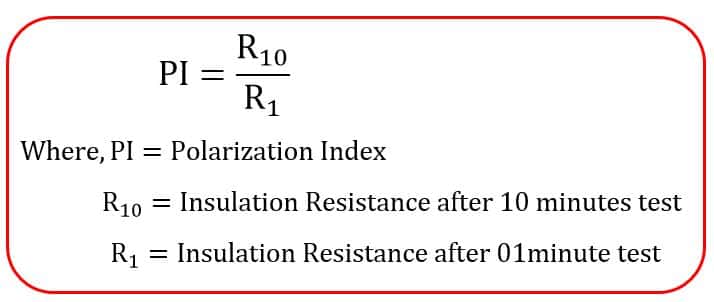
How to perform the polarization Index (PI) Testing?
For determining PI, the insulation resistance is measured at different times after the start of the test. The DC voltage is applied between the conductor and insulation, and then the insulation resistance is measured after 01 minute and 10 minutes of starting the test. If insulation resistance is 300 MΩ and 600 MΩ after 01 and 10 minutes, respectively. The PI is 600/300 = 2
Mechanism of Polarization Current in Insulating Material
When voltage is applied across an insulator, the flow of current in the insulator can be broadly categorized into four categories. Four components of current decide the polarization index of insulating materials.
Capacitive Current (IC)
The insulator acts as a capacitor. When the DC voltage is applied to the capacitor, it draws a high charging current. When all the dielectric gets polarized, the current is reduced to zero—the charging current decays exponentially. In the case of a generator or motor winding, the charging current decays at faster rates and effectively decays to zero in less than 10 seconds. The IR value must be taken after the decay of the capacitive charging current for the correct measurement of insulation resistance.
Conduction Current( IR )
This current is due to the flow of electrons between the conducting material and the insulating material. This is a galvanic current through the ground wall. Such a current can flow if the ground wall has absorbed moisture, which can happen on the older thermoplastic insulation systems.
The current may also flow if there are cracks, cuts, or pinholes in the ground insulation and some contamination is present to allow the current to flow. This current is constant with time. With modern insulation, this current usually is zero (as long as there is no damage to the insulation).
Surface leakage Current(IS)
This is a constant DC current that flows over the surface of the insulation. It is caused by conductive contamination (oil or moisture mixed with dust, dirt, insects, chemicals, etc) on the surface of the winding. This current is also constant with time.
Polarization Current(IP)
Electrical insulation is hygroscopic, and the presence of moisture will be there either in low quantity or in excess. When an electric field is applied across the insulation, it starts absorbing electrons from the hydrogen molecules, causing the ionization of hydrogen. The molecules on the insulator containing water start aligning in the electric field.
The energy required to align the molecules comes from the current in the DC test voltage supply. This current is called polarization current. The water becomes completely polarized when the absorption of electrons from hydrogen merging with oxygen is completed. Once the molecules get aligned, the current stops. The approximate time for complete polarization is 10 minutes. That is why the IR is measured after 10 minutes of applying voltage.
Significance of Polarization Index Test and DAR Test
From the above discussion, it is clear that the insulator must be fully polarized, and the leakage current and conduction current should be reduced.
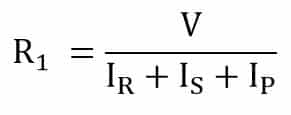
Insulation resistance after 01 minute IR test
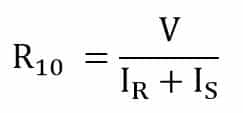
The polarization index test is;
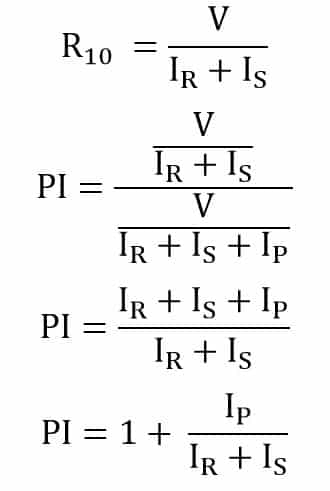
If the value of (IR + IS ) is low compared to polarization current(IP), then the PI value is more than 1. The value of (IR + IS )<< IP for better PI value.
A low value of PI indicates that the winding is contaminated with oil, dirt, or winding has absorbed moisture. The polarization Index curve is shown below.

Example:
Polarization Index PI Calculation of a 6.6 kV Motor Winding

What should be the Minimum PI (Polarization Index) Value?
The Polarization Index acceptable insulation values are given in the table below. This is the general guideline for interpreting the polarization index test results. The PI value of the electrical insulator should be more than 2.
Polarization Index Table
The following table shows the PI values and condition of the electrical insulator.

Dielectric Absorption Ratio (DA or DAR) Test
DAR or DA test is also the ratio test carried out to determine the quality of the insulation. The DAR test is conducted for a lesser time than the PI test. The instantaneous insulation resistance test does not give the exact reading because the insulating material draws a charging current initially and decays after some time. The capacitive current must decay within 01-minute if the insulation is healthy.
Dielectric Absorption Ratio Formula
Dielectric Absorption Ratio (DA or DAR) is the ratio of insulation resistance after 60 seconds and 30 seconds.
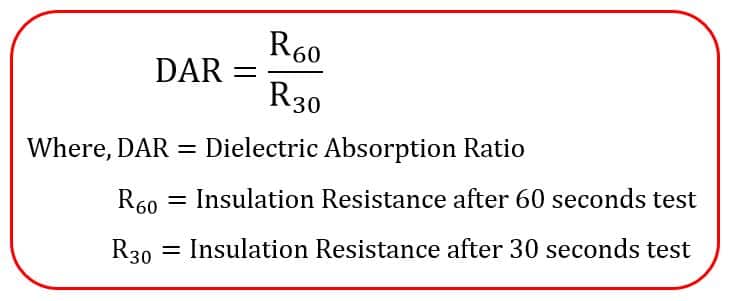
How to perform DAR Test?
To determine DAR or DA, the insulation resistance is measured at different times after the start of the test. The DC voltage is applied between the conductor and insulation, and then the insulation resistance is measured after 30 seconds and 60 seconds of starting the test. If insulation resistance is 100 MΩ and 25 MΩ after 60 seconds and 30 seconds respectively. The DAR is 100/25 = 4
Advantages of the Polarization Index Test and DAR Test
The insulation resistance of the insulating material decreases with an increase in temperature. Thus, the spontaneous value of IR depends on the temperature of the insulating material. That is why the one reading of the IR value does not give an accurate result.
The PI and DA test is the ratio test, and the temperature remains the same in both the readings taken at different times and the measurement is independent of temperature. Therefore, the PI and DA tests give accurate results.